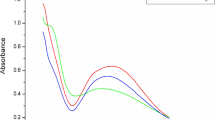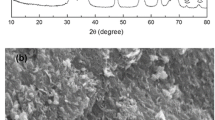Abstract
This article focuses on the development of a durable multi-functional finish for cotton fabric by direct synthesis of nano zinc oxide (nano-ZnO) particles in the pores of the fibres. Anions and cations of zinc nitrate interacted with cellulose molecules and opened up the internal pore structure of cellulosic fibrils that in turn acted as nucleating sites for the formation of nano-ZnO on reaction with sodium hydroxide. The finished fabric was characterized using XRD, FTIR, SEM, TEM, AAS, DSC and AFM. The finished fabric displayed excellent antibacterial activities (>99%) against two pathogens, Staphylococcus aureus (Gram-positive) and Klebsiella pneumoniae (Gram-negative) with 40 UPF even after 30 washes confirming the utility of this method. Inherent physical and mechanical properties of the fabric were found to be unaffected. Low stress mechanical properties evaluated by Kawabata Evaluation System for Fabrics indicated that the total hand value of the finished fabric changed from 3.54 to 3.40. A plausible mechanism for in situ formation of nano-ZnO and its durability on cotton fabric has been proposed.









Similar content being viewed by others
References
Arputharaj A, Prasad V, Saxena S, Vigneshwaran N, Shukla SR (2016) Ionic liquid mediated application of nano zinc oxide on cotton fabric for multi-functional properties. J Text Inst. doi:10.1080/00405000.2016.1222984
Atmaca S, Kadri GÜL, Ciçek R (1998) The effect of zinc on microbial growth. Turk J Med Sci 28:595–598
Baldwin S, Odio MR, Haines SL, O’Connor RJ, Englehart JS, Lane AT (2001) Skin benefits from continuous topical administration of a zinc oxide/petrolatum formulation by a novel disposable diaper. JEADV 15:5–11
Basak S, Samanta KK, Chattopadhyay SK (2015) Fire retardant property of cotton fabric treated with herbal extract. J Text Inst 106:1338–1347
Bertoniere NR, King WD (1989) Effect of scouring/bleaching, caustic mercerization, and liquid ammonia treatment on the pore structure of cotton textile fibers. Text Res J 59:114–121
Dhandapani P, Siddarth AS, Kamalasekaran S, Maruthamuthu S, Rajagopal G (2014) Bio-approach: ureolytic bacteria mediated synthesis of ZnO nanocrystals on cotton fabric and evaluation of their antibacterial properties. Carbohydr Polym 103:448–455
El-Hady MA, Farouk A, Sharaf S (2013) Flame retardancy and UV protection of cotton based fabrics using nano ZnO and polycarboxylic acids. Carbohydr Polym 92:400–406
Gokarneshan N, Rachel DA, Rajendran V, Lavanya B, Ghoshal A (2015) Emerging research trends in medical textiles. Springer, Singapore
Kan CW, Lam YL (2013) Low stress mechanical properties of plasma-treated cotton fabric subjected to zinc oxide-anti-microbial treatment. Materials 6:314–333
Kathirvelu S, D’souza L, Dhurai B (2009) UV protection finishing of textiles using ZnO nanoparticles. Indian J Fibre Text 34:267–273
Khosravian S, Montazer M, Malek RM, Harifi T (2015) In situ synthesis of nano ZnO on starch sized cotton introducing nano photo active fabric optimized with response surface methodology. Carbohydr Polym 132:126–133
Owens DK, Wendt RC (1969) Estimation of the surface free energy of polymers. J Appl Polym Sci 13:1741–1747
Perelshtein I, Applerot G, Perkas N, Wehrschetz-Sigl E, Hasmann A, Guebitz GM, Gedanken A (2009) Antibacterial properties of an in situ generated and simultaneously deposited nanocrystalline ZnO on fabrics. ACS Appl Mater Interfaces 1:361–366
Race E, Speakman JB, Rowe FM (1945) The dyeing of cotton with mineral khaki part vii-the fungicidal and bactericidal efficiencies of cotton yarn treated by various mineral khaki processes. J Soc Dyers Colour 61:310–321
Saif MJ, Zia KM, Rehman FU, Ahmad MN (2015) An eco-friendly, permanent, and non-leaching antimicrobial coating on cotton fabrics. J Text Inst 106:907–911
Shaheen TI, El-Naggar ME, Abdelgawad AM, Hebeish A (2016) Durable antibacterial and UV protections of in situ synthesized Zinc oxide nanoparticles onto cotton fabrics. Int J Biol Macromol 83:426–432
Sirelkhatim A, Mahmud S, Seeni A, Kiran S, Gulzar T (2015) Review on zinc oxide nanoparticles: antibacterial activity and toxicity mechanism. Nano-Micro Lett 7:219–242
Subash AA, Chandramouli KV, Ramachandran T, Rajendran R, Muthusamy M (2012) Preparation, characterization, and functional analysis of zinc oxide nanoparticle-coated cotton fabric for antibacterial efficacy. J Text Inst 103:298–303
Uysala I, Severcana F, Evis Z (2013) Characterization by Fourier transform infrared spectroscopy of hydroxyapatite co-doped with zinc and fluoride. Ceram Int 39:7727–7733
Vigneshwaran N, Sampath K, Kathe AA, Varadarajan PV, Prasad V (2006) Functional finishing of cotton fabric using zinc oxide—soluble starch nano composites. Nanotechnology 17:5087–5095
Acknowledgments
Authors are thankful to Dr. P. G. Patil, Director, ICAR-CIRCOT for his guidance and permission to publish this paper. The authors would like to acknowledge SAIF, IIT-Bombay for the EDX and TEM characterization.
Author information
Authors and Affiliations
Corresponding author
Rights and permissions
About this article
Cite this article
Arputharaj, A., Nadanathangam, V. & Shukla, S.R. A simple and efficient protocol to develop durable multifunctional property to cellulosic materials using in situ generated nano-ZnO. Cellulose 24, 3399–3410 (2017). https://doi.org/10.1007/s10570-017-1335-5
Received:
Accepted:
Published:
Issue Date:
DOI: https://doi.org/10.1007/s10570-017-1335-5




